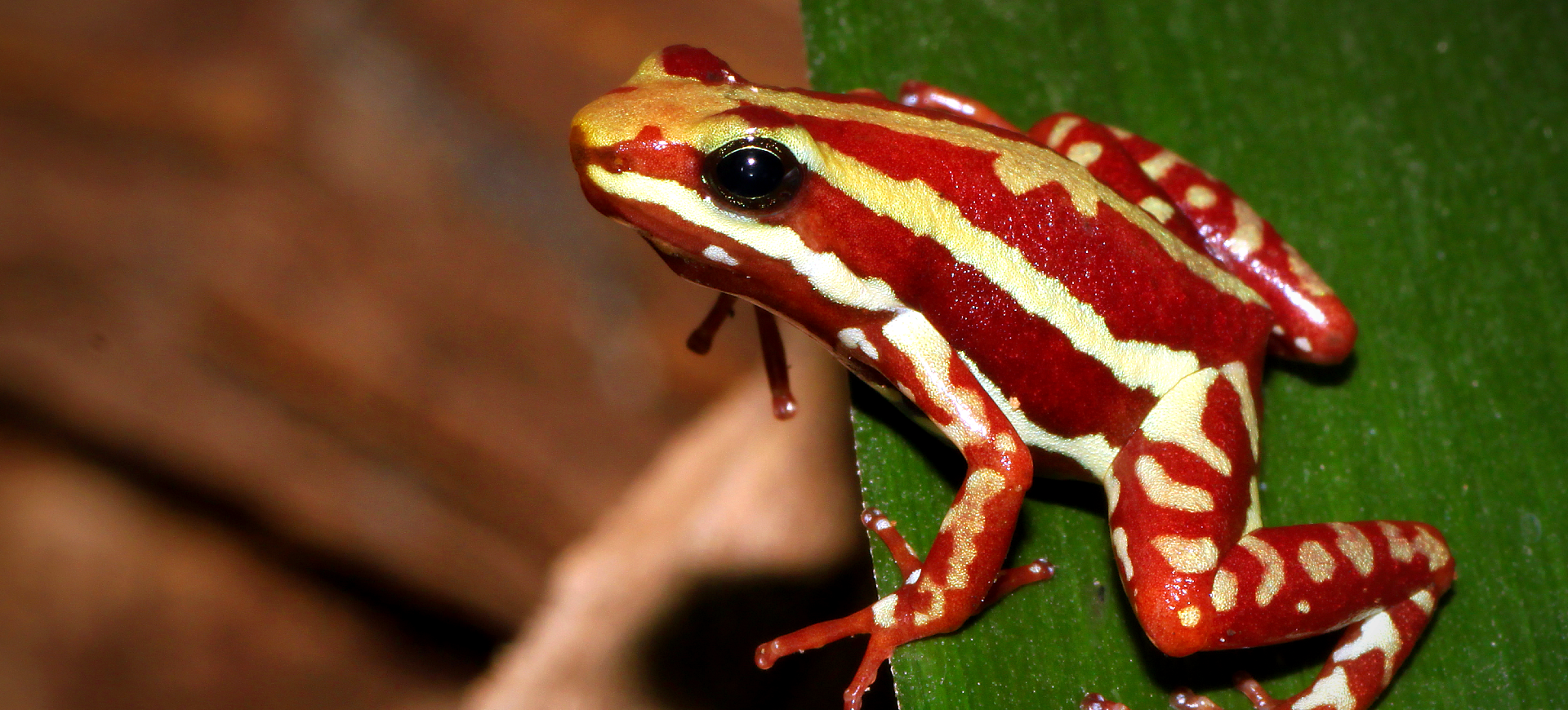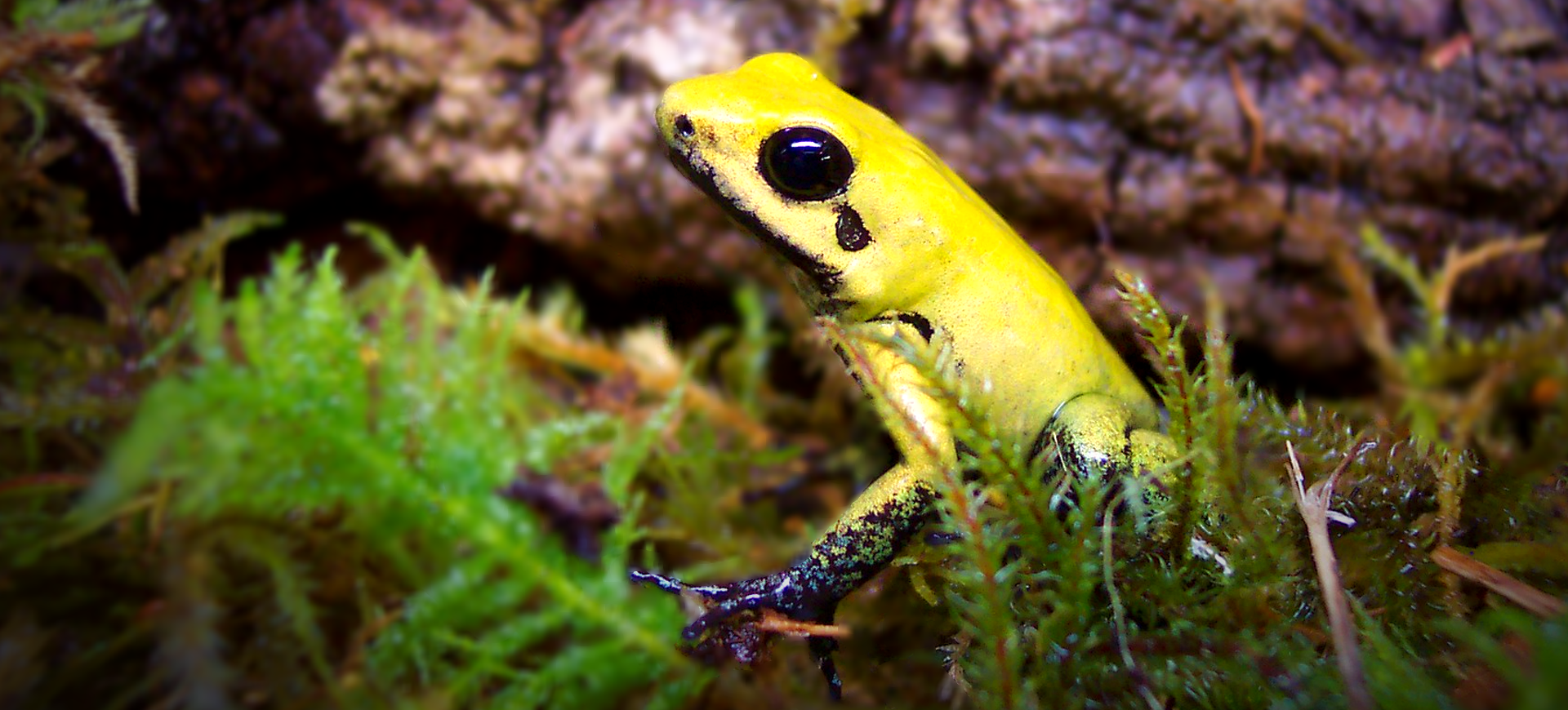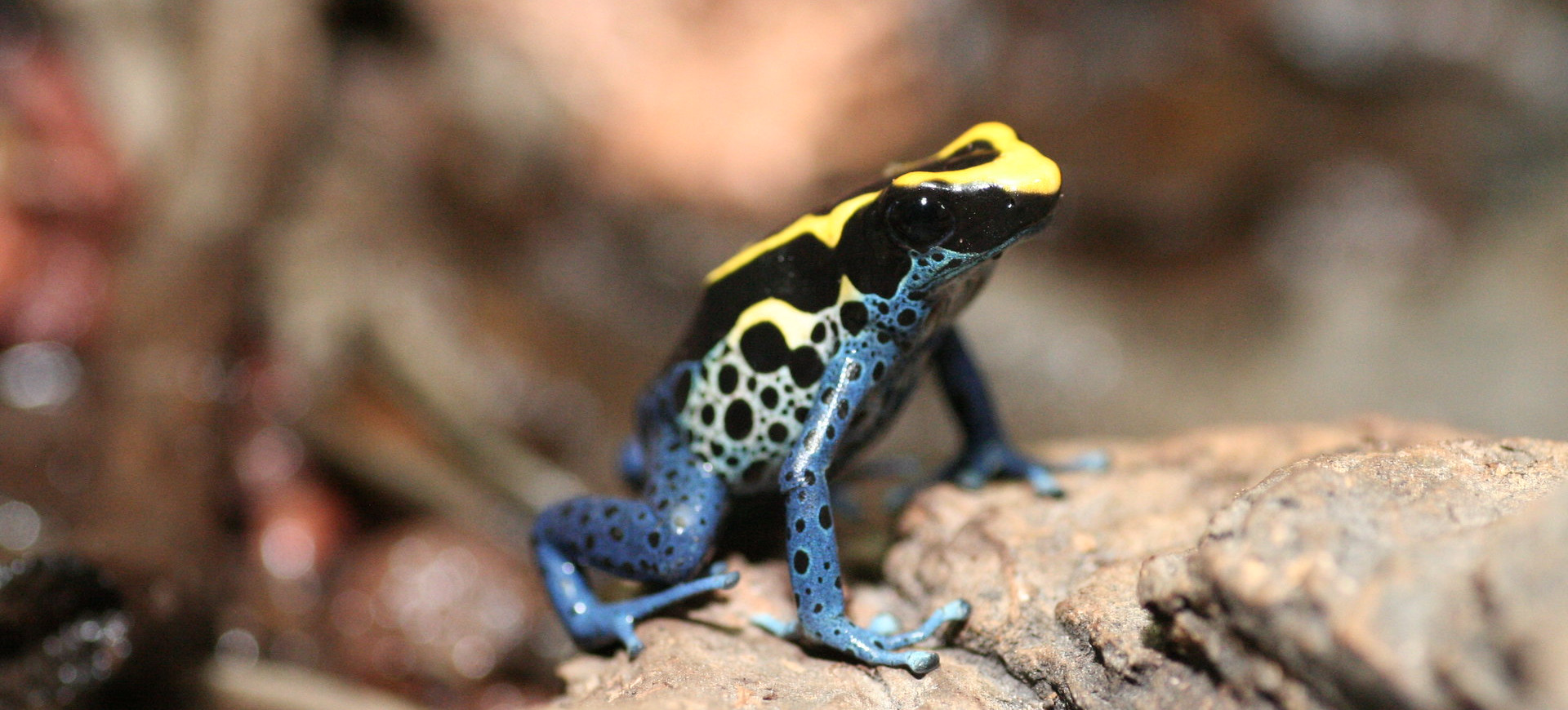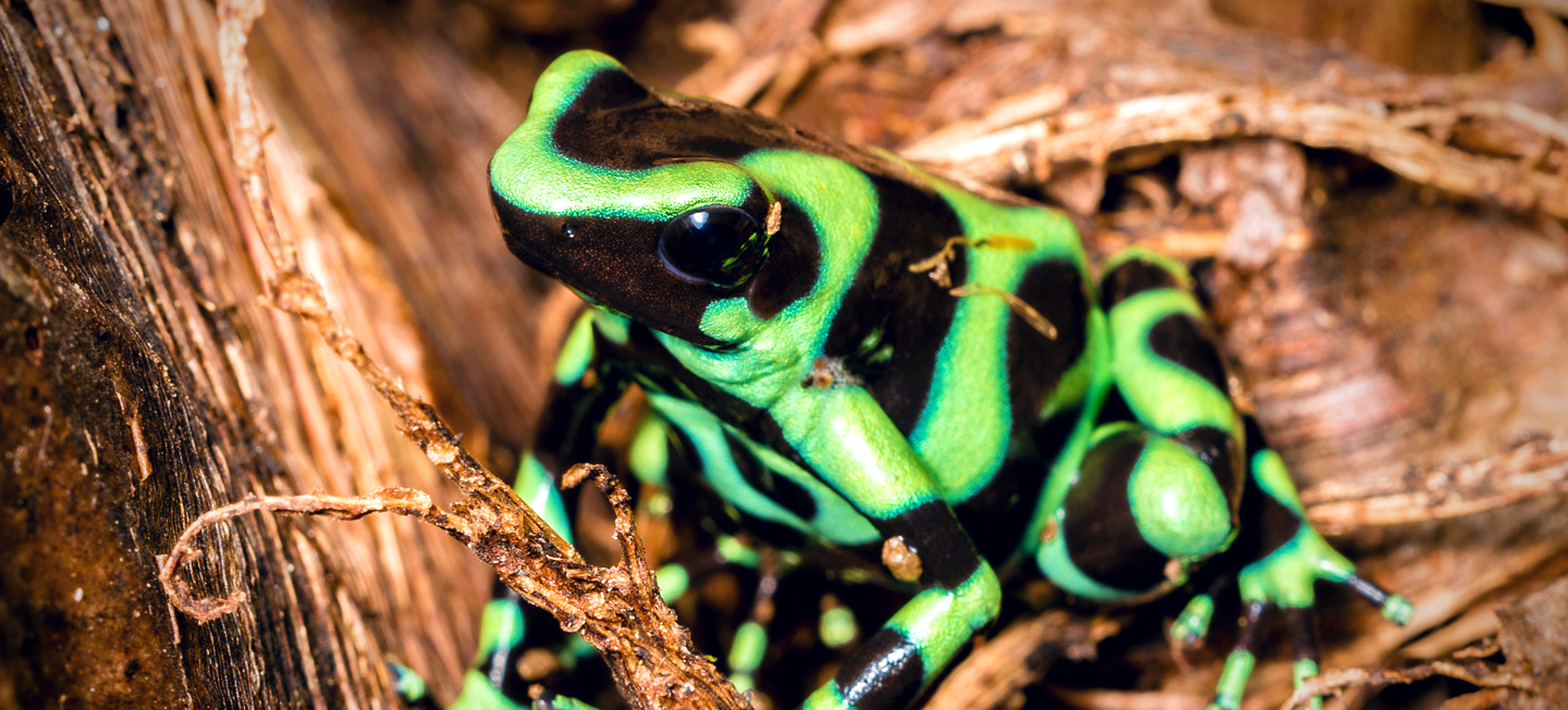Overview
The Golfodulcean Poison Frog, scientifically named Phyllobates vittatus, is a small yet striking amphibian native to Costa Rica. Characterized by its vibrant black and orange coloration, this species belongs to the family Dendrobatidae, commonly known as poison dart frogs. Despite its small size, typically reaching only about 1 to 1.5 inches in length, the frog’s bright colors warn predators about its toxic nature. The toxins, specifically alkaloids, are derived from the frog’s diet and are used as a defense mechanism against predation.
In the wild, Golfodulcean Poison Frogs are typically found in humid lowland rainforests, particularly in areas with dense vegetation and ample leaf litter. They are diurnal creatures, active during the day, hunting for small invertebrates to feed on. Their diet primarily consists of ants and mites, contributing to the frog’s toxicity. The species is known for its intricate mating calls and behaviors, critical for attracting mates and successful reproduction.
While the Golfodulcean Poison Frog is not the most toxic in its family, it still possesses enough toxins to deter most predators. The indigenous people of the frog’s native region have not traditionally used the secretions of this particular species for hunting, unlike some of its more toxic relatives. Conservation efforts are crucial for this species due to its limited range and the ongoing threats to its habitat, including deforestation and pollution.
Taxonomy
Kingdom
Phylum
Class
Order
Family
Genus
Species
Type
Physical Description:
The Golfodulcean Poison Frog is a small amphibian with a slender body and relatively long legs, which aid in its agility and climbing ability. Adults typically exhibit a striking contrast of black and bright orange or yellow stripes, running longitudinally down the body, warning potential predators of their toxicity. The frog’s skin is smooth and glossy, enhancing its coloration vibrancy. The eyes are large and prominent with dark pupils and a golden or copper iris, providing the frog with a keen vision for detecting prey and predators.
Despite their toxic nature, these frogs are delicate, with fragile skin permeable to water and gases, allowing cutaneous respiration. The fingers and toes of the Golfodulcean Poison Frog are not webbed, differing from many other amphibian species, which aids in gripping and moving through the forest understory. Females are generally slightly larger than males, a common trait among many amphibians. The vivid coloration of the frog not only serves as a warning but also varies slightly among individuals, making each frog somewhat unique.

Lifespan: Wild: ~5 Years || Captivity: ~20 Years

Weight: Male & Female: 2-4 grams (0.07-0.14 oz)

Length: Male & Female: 1.18-1.57 inches (2.9-3.9 cm)
Characteristic:
Native Habitat:
Golfodulcean Poison Frogs are native to a very narrow region in the Golfo Dulce area of Costa Rica. They thrive in humid, lowland tropical rainforests where the canopy is dense and the forest floor is covered with leaf litter. These areas’ high humidity and consistent temperature are crucial for their survival, providing the environment for their skin to remain moist and for the frogs to perform cutaneous respiration.
The habitat of the Golfodulcean Poison Frog typically includes small streams and pools, which are essential for their reproductive cycle. The leaf litter and underbrush offer ample hiding spots and hunting grounds, crucial for their survival. Their preference for these dense, humid environments makes them sensitive to changes in their habitat, such as deforestation or pollution.
Climate Zones:
Biomes:
WWF Biomes:
Biogeographical Realms:
Continents:
Countries:
Diet:
Diet & Feeding Habits:
The Golfodulcean Poison Frog is an insectivore, feeding primarily on small invertebrates in its rainforest habitat. Ants and mites comprise a significant portion of its diet, which is believed to contribute to the frog’s toxicity. These frogs use their long, sticky tongues to capture prey quickly and efficiently. Being diurnal, they hunt during the day when their vision is most effective.
The feeding habits of the Golfodulcean Poison Frog play a crucial role in the ecosystem, helping to control the populations of insects and other small invertebrates. The frogs are methodical hunters, often waiting and watching before striking with precision. They require a consistent food supply to maintain their energy levels and toxin production, which in turn protects against predators. They can adapt to a diet of commercially available fruit flies and other small insects in captivity.
Mating Behavior:
Mating Description:
The Golfodulcean Poison Frog exhibits intricate mating behaviors, with males calling to attract females with chirps and trills. These calls are often performed from elevated positions like leaves or branches. Once a female is attracted, the male leads her to a suitable site, typically a moist area or near a water source, where she can lay her eggs.
After laying the eggs, the male often guards them until they hatch, ensuring their safety from predators and desiccation. Once the tadpoles emerge, one of the parents, typically the male, transports them on their back to a nearby water source, where they will continue their development. The parental care exhibited by the Golfodulcean Poison Frog is crucial for the survival of the offspring, as the dense rainforest floor is fraught with predators and other dangers.
Reproduction Season:
Birth Type:
Pregnancy Duration:
Female Name:
Male Name:
Baby Name:
Social Structure Description:
Golfodulcean Poison Frogs are generally solitary creatures, coming together only for breeding. Outside of the breeding season, they maintain individual territories, which they defend from others of the same species. Their bright coloration warns potential predators, but it also plays a role in social interactions, signaling their toxicity to other frogs and animals.
During the breeding season, males become more social, calling to attract females and interacting more frequently with other males, often aggressively. The parental care exhibited by these frogs, particularly the transportation of tadpoles to water sources, is a rare example of social behavior in this otherwise solitary species. Understanding the social structure of the Golfodulcean Poison Frog is crucial for conservation efforts, particularly in terms of managing populations and designing protected areas.
Groups:
Conservation Status:
Population Trend:
The Golfodulcean Poison Frog is currently classified as Endangered by the IUCN, primarily due to its limited range and its habitat’s ongoing loss and degradation. The exact population numbers are unknown but are believed to be decreasing. The frogs’ reliance on specific environmental conditions makes them particularly vulnerable to changes in their habitat, such as deforestation and pollution.
Conservation efforts are focused on protecting the remaining rainforest areas where these frogs live and promoting sustainable land use practices in the region. Understanding the frogs’ biology and ecology is crucial for developing effective conservation strategies. Despite the challenges, there is hope that the decline of this vibrant and unique species can be halted with continued effort and awareness.
Population Threats:
The primary threat to the Golfodulcean Poison Frog is habitat loss due to deforestation, agriculture, and urban development. As their habitat is destroyed or degraded, the frogs lose their hunting grounds, breeding sites, and the specific environmental conditions they need to survive. Pollution from agricultural runoff and other sources can also impact their health and the health of the ecosystem they depend on.
The frogs’ limited range and specific habitat requirements make them particularly vulnerable to these threats. Climate change poses an additional risk, potentially altering their habitat’s temperature and humidity levels and disrupting their breeding cycles. These threats make conserving the Golfodulcean Poison Frog and its habitat a critical priority.
Conservation Efforts:
The Golfodulcean Poison Frog’s conservation efforts focus on habitat protection and restoration. Protecting the remaining rainforest areas where the frogs live is crucial for survival. Efforts are also being made to promote sustainable land use practices in the region to minimize further habitat loss and degradation.
Captive breeding programs have been established to help maintain the population and potentially reintroduce frogs into protected areas. Research into the frogs’ biology, ecology, and the impacts of environmental changes is also essential for informing conservation strategies. Education and awareness programs can help garner support for these efforts and ensure the long-term survival of this unique species.
Additional Resources:
Fun Facts
- Despite their toxicity, Golfodulcean Poison Frogs are not dangerous to humans unless the toxins are ingested or enter the bloodstream.
- The bright coloration of these frogs is a classic example of aposematism, where a species evolves to be highly visible and recognizable to predators as a warning of its toxicity.
- Golfodulcean Poison Frogs exhibit high parental care, with males often guarding the eggs and transporting the tadpoles to water.
- The frogs’ toxins come from their diet of ants and other invertebrates, which contain alkaloid compounds.
- In the wild, these frogs can be difficult to spot due to their small size and the dense vegetation of their habitat.
- The chirping call of the male Golfodulcean Poison Frog is unique and can be heard during the day, unlike many other frog species that call at night.
- Despite their name, poison dart frogs like the Golfodulcean have not been used for poison darts in their native region.
- The Golfodulcean Poison Frog is a less toxic species in the Dendrobatidae family, although it is still dangerous to potential predators.
- Captive-bred Golfodulcean Poison Frogs often lose their toxicity due to a diet that doesn’t include the specific invertebrates they consume in the wild.
- These frogs are an important part of the rainforest ecosystem, helping to control insect populations and serving as indicators of environmental health.









